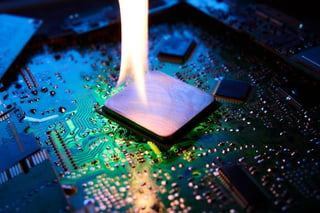 Thanks to increasingly effective servers, meteorologists are predicting weather more accurately, scientists are crafting new vaccines using genetic sequencing, and doctors are diagnosing patients faster with the best resources available. As technology advances, however, the demands placed on servers also increases. Projections indicate that by the end of 2023, the internet will be comprised of 114 zettabytes of information, and that number will only increase with time. This equation leads to increased energy consumption which means more heat production. Increased heat production often results in a decrease in system performance.
Thanks to increasingly effective servers, meteorologists are predicting weather more accurately, scientists are crafting new vaccines using genetic sequencing, and doctors are diagnosing patients faster with the best resources available. As technology advances, however, the demands placed on servers also increases. Projections indicate that by the end of 2023, the internet will be comprised of 114 zettabytes of information, and that number will only increase with time. This equation leads to increased energy consumption which means more heat production. Increased heat production often results in a decrease in system performance.
To combat this issue, Dell has incorporated AI-driven cooling into its PowerEdge server line. This exciting technology uses thermal and mechanical simulation tools to optimize cooling and ensure sustained system performance. In this article, we discuss the benefits of smart cooling technology and how it is helping Dell EMC continue to push the boundaries of technological innovation.
How Does Smart Cooling Technology Work?
There are three primary methods servers employ to ensure that the system is not overwhelmed by heat production. This includes air cooling (or multi-vector cooling), direct liquid cooling (DLC), immersion cooling, or a combination of these technologies.
Each of these options come with their own benefits and methods, which I have outlined in detail below:
Air Cooling: Multi-vector cooling (MVC) maximizes the potential of air cooling. This cutting-edge technology employs a complex system of cost-effective and high-performing fans and heatsinks that streamline airflow and air temperature distribution across the chassis.
If the fans and heatsinks were not enough, the design of the system itself is engineered to prevent systems from overheating. In PowerEdge servers, the motherboard is T-shaped, and the power supply units are located at each corner of the chassis. This allows for improved airflow and system cooling.
Direct Liquid Cooling: This smart cooling technology uses liquid to absorb and remove heat created by high-power processors. For those concerned about potential leaks, Dell solutions also include Leak Sense technology. This intelligent system alerts customers of minor and major leaks and offers increased configuration.
Immersion Cooling: This cooling method is designed for power-dense systems operating in spaces with little or no conditioned air. In immersion cooling, the systems are submerged in a tank of liquid which captures 100% of the heat.
Making Smart Cooling Technology Smarter
When combined, air cooling, direct liquid cooling, and immersion cooling provide increased assurance that your system will not overheat or suffer any performance issues. But what really sets PowerEdge servers apart is the integration of artificial intelligence and system tools.
Dell’s servers now offer OpenManage Enterprise Power Manager, a tool which gives customers full insight and control of how their system prioritizes cooling. Here are a few ways this system serves customers:
- Allows users to monitor and manage power and thermal consumption for individual and groups of servers.
- Provides reports to help meet sustainability goals.
- Utilizes policies to set power caps at the rack or group level.
- Supports enhanced visualization of data center racks with power and thermal readings.
- Informs users of the power of virtual machine usage for a physical device.
- Shares information on server performance metrics.
This smart cooling system includes an integrated Dell Remote Access Controller (iDRAC). This tool allows users to maximize resource use and adjust power when there is a decreased demand for performance. The Power Manager also provides pre-defined power policies, ensuring that users’ key workloads continue to operate.
Smart Cooling Technology And Sustainability
While performance is a primary concern for most IT-centric companies, preserving the environment is also of growing importance. Fortunately, customers who implement PowerEdge servers into their system will have a clean conscious.
Here are a few ways these servers have integrated environmentalism into their strategies:
- Decreased Drain On Energy Resources: Using the tools Power Manager provides, users will reduce expenses, maintain availability, and decrease power usage.
- Fewer Replacements: By using tools like MVC and DLC to keep your systems cool, users will replace tools less frequently. This will not only save you money but also decrease your carbon footprint.
- Power Caps: OpenManage allows administrators to place power caps on racks/rows/rooms of servers. When used effectively (especially when performance demand is lower) this has a significant impact on the energy drain of a data center.
Final Thoughts
Whether you are looking for ways to decrease your expenses, reduce your carbon footprint, or improve your system performance, smart cooling technology is the right choice for you. If you would like to begin integrating Dell’s PowerEdge servers into your system, we can get you started. We help businesses of all sizes every step of the way, from purchase through implementation. Contact us today to discover which tools are the right fit for you!
Next Steps: Discover more about refreshing your servers and enhancing digital transformation by downloading our tech brief, Accelerating IT Modernization with Server Refresh.











